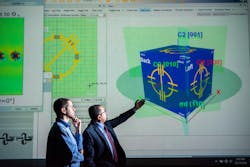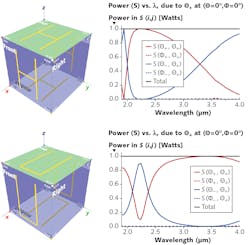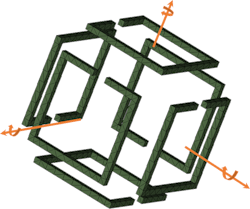Free-license software removes trial and error in metamaterial design
IHAB EL-KADY
I was thrilled when I met a professor who had created a remarkable metalens. It exhibited an ability to focus light in a way I had never seen, which was documented in a proof-of-concept paper published in a renowned journal. Its potential to spark revolutionary new technologies—to me—seemed extraordinary.
But the professor’s optimism was muted. Progress had run aground in development. A year of work had resulted in a device that correctly affected only 60% of the light that passed through it—the value was effectively closer to 30% because it could only focus light in one polarization instead of both. The practical value of the device was in question.
Unfortunately, the field of metamaterials is rife with stories like this one. Because metamaterials can exhibit properties not normally found in nature, the allure of transformational technologies has tantalized researchers for more than a decade. Among the hottest areas of research are flat lenses and enhanced nonlinear optics. If such promises are realized, virtually every field of research that uses imaging—from biology to astronomy, archaeology to high-energy physics—stands to benefit.
And while much progress has been made, in many cases the design process proves overwhelming because fundamental metamaterial design principles have not been well established, and as a result some researchers resort to trial and error. Ultimately, many innovative technologies are abandoned only because of the inherent ineffectiveness of the guessing process.
A new, more efficient way of creating metamaterials developed at Sandia National Laboratories should give this area of optics a technological boost. On behalf of the Defense Advanced Research Projects Agency (DARPA), Sandia’s National Security Photonics Center developed what we believe is the first inverse-design metamaterials software called MIRaGE—short for Multiscale Inverse Rapid Group-theory for Engineered-metamaterials. In other words, a user tells MIRaGE what he or she wants a metamaterial to do, and the program fills in the steps to create it.Inverse design principles
When I met the professor with the metalens, I offered to show him the difference this new design approach could make. I took his problem to my colleague, Sandia research scientist Charles Reinke, who also helped develop MIRaGE (see Fig. 1). I described to him the professor’s problem and instructed him on a way forward that enabled us to create from scratch a biaxial metamaterial—one that could interact with light equally in the x and y dimensions (assuming propagation in the z direction).
We opened the MIRaGE project and went to work. Instead of starting with a drawing board, we started with the MIRaGE interactive tensor tool—a grid of buttons representing the desired electromagnetic behavior. We selected options that corresponded to the behavior the professor wanted. The MIRaGE software presented a collection of example meta-atoms that met these conditions.
We then filtered the results by asking a few simple questions: Did the university have fabrication tools to build out in multiple planes? No? Not a problem. We ignored the options that would require those tools and selected the example that made the most sense for his fabrication capabilities.
At this point, MIRaGE decided on design rules that a meta-atom would have to obey. Now, we could switch into a sketching mode with a look and feel similar to other computer-aided design (CAD) programs.
The symmetry checking engine in MIRaGE offered him corrective feedback whenever we inadvertently introduced geometrical features that would spoil his selected behavior. In a similar vein, by switching to a different mode, MIRaGE can also offer predictive guidance by suggesting geometrical features that should be added to steer the design away from undesired behaviors. These suggestions quickly pruned his search space and allowed him to focus on shapes that were most likely to strongly exhibit the desired electromagnetic behavior.
After designing a qualified meta-atom, Reinke ran a quick simulation within MIRaGE to confirm the predicted behavior and then used built-in optimization tools to help tile a row of 10 meta-atoms with various designs to manipulate light with different phase responses. The result was 45% efficient and worked for unpolarized light—significantly better than the effective 30% efficiency of the original design the professor had developed. The total number of man hours was about seven, a much shorter investment when compared to the full year of tweaking spent developing the original design. MIRaGE had enabled him to do in one working day what a team of excellent minds had needed a year to accomplish.
Group theory—a powerful tool
This tremendous time savings is possible because MIRaGE is based on group theory, a mathematical concept not always familiar to engineers. Chemists, for example, use the theory to explain that two molecules, regardless of whether they look like each other or are composed of different elements, can have the same optical properties if they have the same symmetry.
It turns out the same holds true for meta-atoms—the tiny, engineered building blocks that give metamaterials their unusual properties. Their optical qualities are not just based on the thickness of loops and width of gaps, but are heavily influenced by the symmetry of the whole design.
We based our work on research that previously recognized the applicability of group theory to optical metamaterials.1, 2 To our knowledge, though, this idea has never been applied as it currently is in MIRaGE.
Group theory as a first principle of metamaterial design elucidates the bulk, homogenized behavior that is otherwise difficult to predict. For example, two meta-atoms can display dramatically different scattering behaviors, with much more interference in the “H” configuration than the “U” (see Fig. 2). Despite the geometrical similarities, group theory recognizes these as having two distinct symmetries that explain the difference in observed behaviors. For example, the “H” configuration is symmetrical along both its central x and y axes, but the “U” is not at all symmetrical along its x axis.
Configurations with the same symmetry, on the other hand, have the same optical properties. So, the elegance of group theory is that it allows researchers to focus on only those designs that are relevant to the behavior they want. It takes infinite design possibilities and sets a limit.
Consider the basic split-ring resonator. If a researcher made a meta-atom by tracing this design onto each of the six sides of a fixed cube and considered each face to have four possible orientations (90° rotations), there are 46, or 4096 ways to configure it (see Fig. 3). This is far too many to sort through by trial and error, given the computational load of each numerical simulation.
However, filtering the results to only those that display a particular behavior, as we did for our academic colleague, immediately limits that number to only a few. And we can further pare down our options by limiting results to those that make sense with the materials and fabrication methods being used.
Built for everyone
Sandia uses MIRaGE in its own work in developing metamaterials for national security applications. Like others, we’ve had moderate success in the past demonstrating interesting concepts, but have found optimization and development to be crucially slow.
Sandia senior scientist Igal Brener is considering using the software to optimize a metamaterial he previously designed. His material transforms light from two lasers into a spectrum of color, and he hopes he can develop his device into a kind of tunable laser that could simplify systems that otherwise require many lasers. Each color, however, comes through with different intensity, some of which are too weak to be useful. Brener is exploring ways to use the advanced optimization algorithms built into MIRaGE to further his research.
REFERENCES
1. W. J. Padilla, Opt. Express, 14, 4, 1639–1646 (Feb. 19, 2007).
2. C. M. Reinke et al., Phys. Rev. E, 83, 066603 (Jun. 16, 2011).
Ihab El-Kady is a principal scientist at Sandia National Laboratories, Albuquerque, NM; e-mail: [email protected]; www.sandia.gov.



